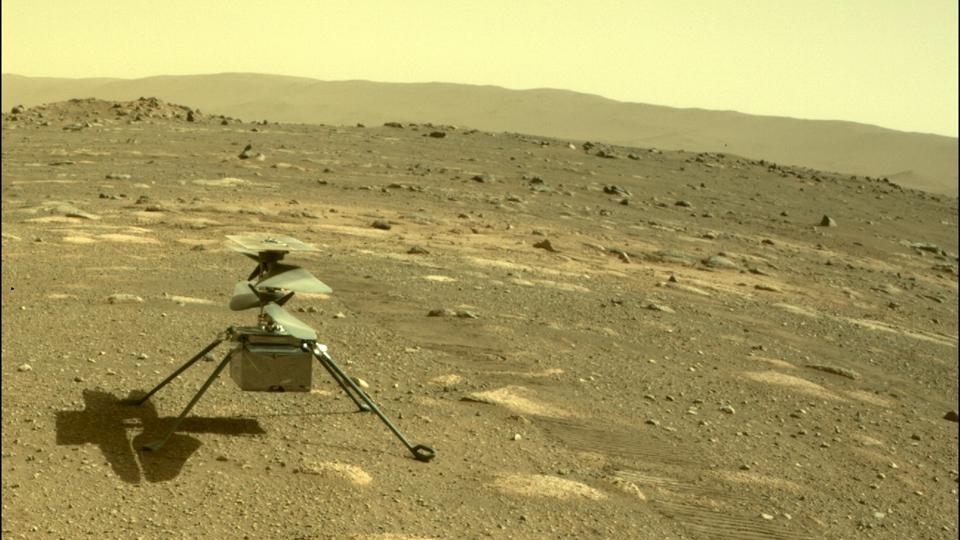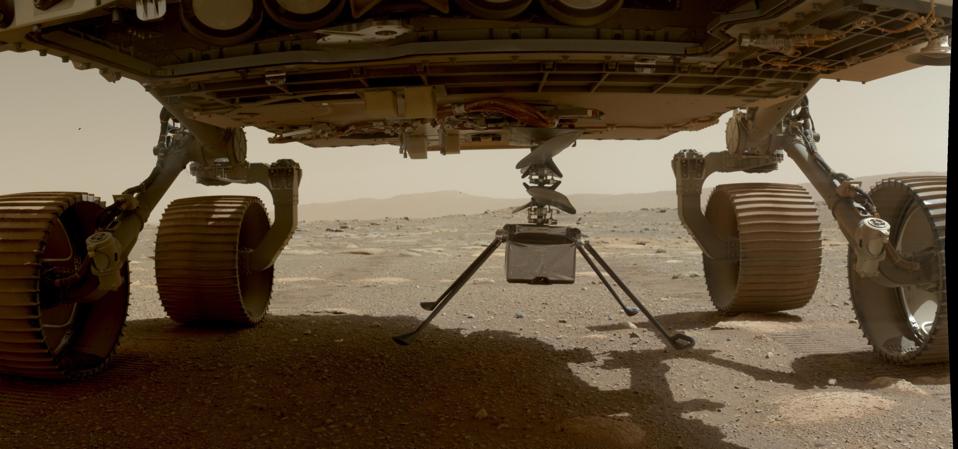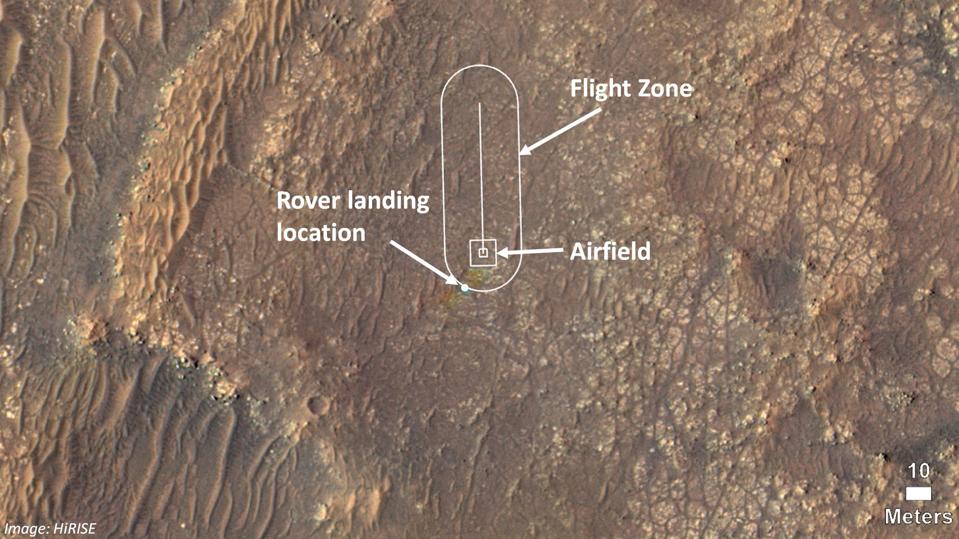
Perseverance is the most sophisticated rover NASA has ever sent to Mars. Ingenuity, a technology … [+]
NASA/JPL-Caltech
Are you ready for a little Ingenuity?
NASA will this week make its first attempt at powered, controlled flight of an aircraft on another planet.
A tiny helicopter called Ingenuity is currently on the Martian surface, having been deposited there by the Perseverance rover, which landed on in the Jezero Crater on February 18.
It just survived a cold Martian night on its own for the first time.
It will make a short, powered flight no earlier than the evening of Sunday, April 11, according to NASA’s Jet Propulsion Lab (JPL).
Will that date—or the few days afterwards—go down in history just as the Wright Brothers’ first flight on Earth did on December 17, 1903? Just in case, Ingenuity is carrying a very special good luck charm from that first powered, controlled flight on Earth.
However, Ingenuity is considered a high-risk, high-reward tech demo, so anything could happen.
Here’s what you need to know—and how to follow it all online:

NASA’s Ingenuity helicopter can be seen on Mars as viewed by the Perseverance rover’s rear Hazard … [+]
NASA/JPL-Caltech
What is Ingenuity?
It’s a three-rotored autonomous rotorcraft—a drone—weighing 4 pounds/1.8 kilograms. Its four carbon fiber blades, arranged into two rotors, will spin in opposite directions at around 2,537 rpm—many times faster than required on Earth—to account for the fact that the atmosphere on Mars is 99% less dense.
When is Ingenuity going to fly and what’s the schedule?
Sunday, April 11 is when to begin checking with NASA. However, the space agency has said that once deployed Ingenuity will have 30 Martian days, or sols, (31 Earth days) to conduct its test flight campaign.
The small rotorcraft already dangling above the Martian surface (see below). As soon as its on the surface the Perseverance rover will drive 16 feet/5 meters away as quickly as possible so Ingenuity can get the Sun’s rays onto its solar panel to begin recharging its batteries.
That 30-sol clock will begin ticking once it’s confirmed that Perseverance and Ingenuity are communicating via radio. That’s crucial because Perseverance will receive and relay to Ingenuity the final flight instructions from JPL mission controllers. Ingenuity is completely autonomous—no one is going to be able to control the helicopter with a joystick because relaying instructions via radio from Earth to Mars takes between five and 20 minutes.
After some preflight checks— including a wiggle of its rotor blades—the flight tests must begin.

NASA’s Ingenuity helicopter can be seen here with all four of its legs deployed before dropping from … [+]
NASA/JPL-Caltech/MSSS
How to watch Ingenuity online
Once checks are complete, Ingenuity will lift off, climbing at a rate of about 3 feet/1 meter per second to hover at 10 feet/3 meters above the surface for up to 30 seconds. It will change direction slightly. Then Ingenuity will then descend and touch back down on the Martian surface.
Increasingly ambitious flights will follow, but we’ll know if this first flight was a success when—several hours after the first flight has occurred—Perseverance downlinks Ingenuity’s first set of engineering data and relays it to Earth. It might also come with some low-resolution black-and-white photos from Ingenuity’s own Navigation Camera. Color images will follow—but no video from Ingenuity itself.
What we’ll see—with any luck—are those images, plus images and video of Ingenuity’s first flight from afar as seen by the Perseverance rover’s Navigation Cameras and Mastcam-Z.
All of that is going to be a very special memento if the first powered, controlled flight of an aircraft on another planet is a success.
The key social media accounts to watch for all this are:
Twitter: @IngenuityNasa @NASAPersevere and @NASAMars
Facebook: NASA, NASA Mars and NASA’s Perseverance Mars Rover
YouTube: NASA TV

This low-resolution view of the floor of Mars’ Jezero Crater and a portion of two wheels of NASA’s … [+]
NASA/JPL-Caltech
Ingenuity’s first photo
Ingenuity actually already sent back its first photo (above). Having been dropped-off on the Martian surface by Perseverance, it sent back this low-resolution color view of the floor—including some of two wheels of the rover. Expect to see higher-resolution images from the same camera during each of Ingenuity’s test flights.

This image shows where NASA’s Ingenuity Mars Helicopter team will attempt its test flights. … [+]
NASA/JPL-Caltech/University of Arizona
How risky is Ingenuity’s first flight?
The Martian atmosphere is a mere 1% as dense as Earth’s at the surface. It also gets only 50% of solar energy that reaches Earth during the day. At night it can get as cold as -130º F/-90ºC, which could freeze and crack Ingenuity’s electrics. So Ingenuity is very lightweight and it has internal heaters powered by solar panels.
“Every step we have taken since this journey began six years ago has been uncharted territory in the history of aircraft,” said Bob Balaram, Mars Helicopter chief engineer at JPL. “And while getting deployed to the surface will be a big challenge, surviving that first night on Mars alone, without the rover protecting it and keeping it powered, will be an even bigger one.”
What happens next if Ingenuity is a success?
Ingenuity will attempt up to five test flights within the 30-Martian-day (31-Earth-day) demonstration window.
After a few very short flights it will fly further and higher in an attempt to see what’s ahead of the Perseverance rover. That’s key on a rocky planet like Mars because much of its surface is too rough for a rover to traverse.
In the long run, a successful flight from Ingenuity could make “rover + drone” the default way to explore a planet’s surface.
As well as providing photos and video for reconnaissance for robots or humans, drones like Ingenuity could access terrain too difficult for rovers to reach, and even carry light payloads from one site to another.
We could even see a clawed-drone on the way to Mars in Ingenuity’s wake.

This illustration shows NASA astronauts working on the surface of Mars. A helicopter similar to the … [+]
NASA
What if Ingenuity fails?
It might do. “Ingenuity is an experimental engineering flight test—we want to see if we can fly at Mars,” said MiMi Aung, project manager for Ingenuity Mars Helicopter at JPL. “There are no science instruments onboard and no goals to obtain scientific information.”
This is about seeing if it’s possible to fly on Mars, so Ingenuity will be gathering as much engineering data as possible to help future missions. Ingenuity is a pathfinder—so if it fails there will be no impact whatsoever on the science-gathering of the Mars 2020 mission won’t be impacted.
“Mars is hard,” said Aung. “Our plan is to work whatever the Red Planet throws at us the very same way we handled every challenge we’ve faced over the past six years – together, with tenacity and a lot of hard work … and a little Ingenuity.”
Either way, Ingenuity won’t go back inside Perseverance. Its tests complete—failure or success—the drone will remain where it lands for the final time. Soon, the rover will be out of range as it continues its land-based journey.
Wishing you clear skies and wide eyes.









